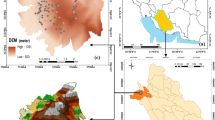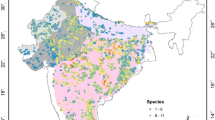Abstract
The article is devoted to modeling the potential distribution habitat of Pulsatilla turczaninovii Kull. et Serg. (Turchaninova prostrate). Modeling of ecological niches of plants is the process of building models using modern computer algorithms and bioclimatic data to predict the habitat distribution of plant species. The result of modeling is a model that can be used to map the area where species grow or live, predict the habitat, or analyze the impact of the environment on species. Building effective models for predicting plant ecological niches requires data on both the presence and absence of species in an area. Species absence points (or background points) are not recorded in databases but can be generated using different approaches. This article describes the implementation of three approaches to selecting pseudo-absence points in a given area: 1) randomly selecting from all points in a given area, excluding existing points of presence; 2) randomly selecting any point located at least one degree of latitude or longitude from any point of presence; 3) random selection of points from all points outside the suitable area estimated based on bioclimatic variables. The article presents the result of modeling the potential distribution range of the species Pulsatilla turczaninovii Kull. et Serg. using the random forest algorithm, the most popular method of constructing ensembles of decision trees. The software implementation of the model is carried out in the high-level programming language Python.
Access this chapter
Tax calculation will be finalised at checkout
Purchases are for personal use only
Similar content being viewed by others
References
Guisan, A., Thuiller, W.: Predicting species distribution: offering more than simple habitat models. Ecol. Lett. 8(9), 993–1009 (2005)
Zaikov, V.F., Vaganov, A.V., Shmakov, A.I.: Climate modeling of the potential range of Pulsatilla turczaninovii Kryl. et Serg. (Ranunculaceae) on the territory of Eurasia. Theor. Appl. Ecol. 1, 140–144 (2022). (in Russian)
Vaganov, A.V., Pokalyakin, Z.V., Khvorova, L.A.: Integrated solution of problems of plant resources assessment using GIS and climate modeling. Probl. Bot. South. Siberia Mongolia 20(1), 87–91 (2021). (in Russian)
Makunina, N.I., Egorova, A.V., Pisarenko, O.: Construction of potential habitats of plant communities for the purpose of botanical and geographical zoning (on the example of Tuva forests). Siberian Ecol. J. 4, 517–524 (2020). https://doi.org/10.1134/s1995425520040095. (in Russian)
Dudov, S.V.: Modeling of species distribution using topography and remote sensing data, with vascular plants of the Tukhuringra Range low mountain belt (Zeya Nature Reserve, Amur Region) as a case study. J. Gen. Biol. 7(1), 16–28 (2016). (in Russian)
Elith, J., Leathwick, J.R.: Species distribution models: ecological explanation and prediction across space and time. Annu. Rev. Ecol. Evol. Syst. 40, 677–697 (2009). https://doi.org/10.1146/annurev.ecolsys.110308.120159
Global Biodiversity Information Facility (GBIF) Occurrence Download [Internet resource]. Accessed 20 Dec 2019. https://doi.org/10.15468/dl.4khq61
Barbet-Massin, M., Jiguet, F., Thuiller, W.: Selecting pseudo-absences for species distribution models: how, where and how many? https://doi.org/10.1111/j.2041-210X.2011.00172.x
Downey, A.B.: Exploring Complex Systems with Python. DMK Press, Moscow (2019). (in Russian)
Vander, P.: Python for Complex Problems: Data Science and Machine Learning. Piter, St. Petersburg (2018). (in Russian)
Raska, S.: Python and Machine Learning: A Tutorial. DMK Press, Moscow (2017). (in Russian)
WorldClim. – Access mode. Head. from the screen. https://www.worldclim.com/node/1. Accessed 30 Apr 2022
Thuiller, W., Lafourcade, B., Engler, R., Araújo, M.B.: BIOMOD – a platform for ensemble forecasting of species distributions. Ecography 32(3), 369–373 (2009)
Poletaeva, N.G.: Classification of machine learning systems. Bull. Baltic Fed. Univ. 1, 5–22 (2020). (in Russian)
Geron, O.: Applied Machine Learning with Scikit-Learn and TensorFlow: Concepts, Tools and Techniques for Building Intelligent Systems. St. Petersburg (2018). (in Russian)
Anderson, R.P., Lew, D., Peterson, A.T.: Evaluating predictive models of species’ distributions: criteria for selecting models. Ecol. Model. 162, 211–232 (2003). https://doi.org/10.1016/s0304-3800(02)00349-6
Barthlott, W., Biedinger, N., Braun, G., Feig, F., Kier, G., Mutke, J.: Terminological and methodological aspects of the mapping and analysis of the global biodiversity. Acta Bot. Fennica 162, 103–110 (1999)
Austin, M.: Species distribution models and ecological theory: a critical assessment and some possible new approaches. Ecol. Model. 200, 1–19 (2007). https://doi.org/10.1016/j.ecolmodel.2006.07.005
Brown, J.L.: SDMtoolbox: a Python-based GIS toolkit for landscape genetic, biogeographic and species distribution model analyses. Methods Ecol. Evol. 5(7), 694–700 (2014). https://doi.org/10.1111/2041-210X.12200
Korznikov, K.A.: Climate envelope models of Kalopanax septemlobus and Phellodendron amurense var. sachalinense in the insular part of the Russian Far East. Izvestiya RAN. Seriya biologicheskaya 6, 648–657 (2019). https://doi.org/10.1134/S1062359019040083 (in Russian)
Hallgren, W., et al.: The biodiversity and climate change virtual laboratory: where ecology meets big data. Environ. Model. Softw. 76, 182–186 (2016). https://doi.org/10.1016/j.envsoft.2015.10.025
Acknowledgments
This work was supported in the framework of the “Priority-2030” Program by Altai State University.
Author information
Authors and Affiliations
Corresponding author
Editor information
Editors and Affiliations
Rights and permissions
Copyright information
© 2023 The Author(s), under exclusive license to Springer Nature Switzerland AG
About this paper
Cite this paper
Vaganov, A.V., Zaikov, V.F., Krotova, O.S., Musokhranov, A.I., Pokalyakin, Z.V., Khvorova, L.A. (2023). Modeling a Potential Plant Habitat by Ensemble Machine Learning. In: Jordan, V., Tarasov, I., Shurina, E., Filimonov, N., Faerman, V. (eds) High-Performance Computing Systems and Technologies in Scientific Research, Automation of Control and Production. HPCST 2022. Communications in Computer and Information Science, vol 1733. Springer, Cham. https://doi.org/10.1007/978-3-031-23744-7_16
Download citation
DOI: https://doi.org/10.1007/978-3-031-23744-7_16
Published:
Publisher Name: Springer, Cham
Print ISBN: 978-3-031-23743-0
Online ISBN: 978-3-031-23744-7
eBook Packages: Computer ScienceComputer Science (R0)




